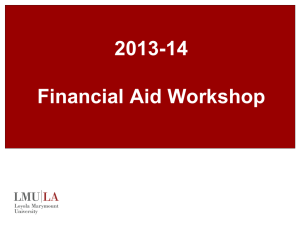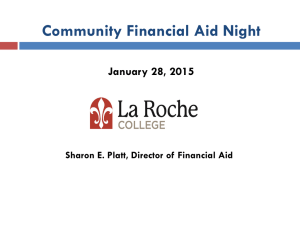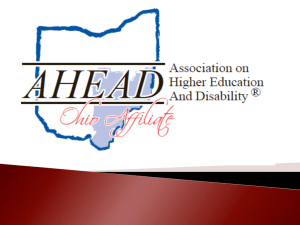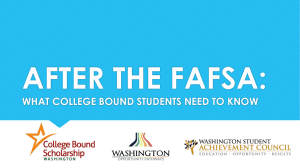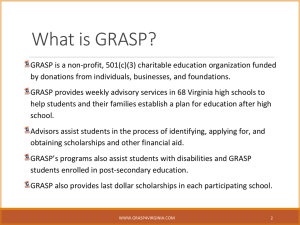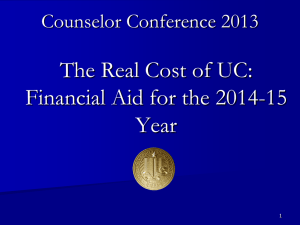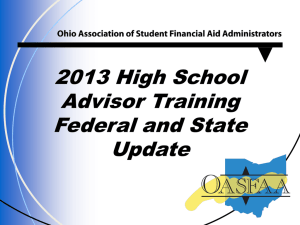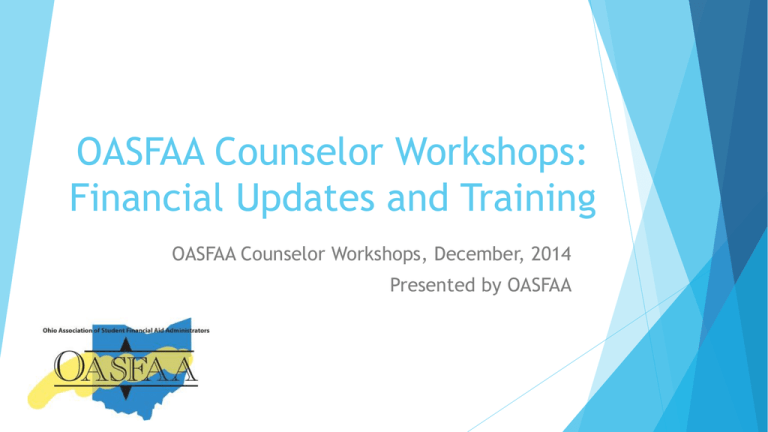
OASFAA Counselor Workshops:
Financial Updates and Training
OASFAA Counselor Workshops, December, 2014
Presented by OASFAA
About OASFAA & this presentation
OASFAA is a non-profit organization comprised of volunteer
financial aid professionals.
OASFAA has provided the information today as a free service to
access staff and high school counselors.
You have permission to copy and distribute these materials to
your students and families. Charges may not be assessed for
the material or for the information presented. Permission must
be granted for other use of this information or these materials.
Contact the OASFAA Outreach Chairperson(s) listed on the
OASFAA website, or e-mail the OASFAA Outreach Committee at
outreach@oasfaa.org.
Agenda
FAFSA Updates, including a review of the new same sex
marriage guidelines.
Federal and State Financial Aid updates.
Education policy updates in light of the upcoming
Reauthorization of the Higher Education Act.
A review of the needs analysis formula that determines a
family’s EFC.
A comparison of actual award letters from Ohio Schools so
you can see how families are actually paying for college.
A review of Counselor Resources
FAFSA Updates – Introducing the FSA ID
FSA is adopting the best practice of using a username and password
instead of personal information
The FSA ID (username and password) will replace PIN for students,
parents and borrowers accessing FSA systems starting on April 25, 2015
Users will not be able to access FAFSA by providing last name, SSN and DOB
after implementation
Only change to FAFSA functionality is that FSA ID will replace PIN information
Must use FSA ID to electronically sign or make changes to the FAFSA
No change to customer support
PLEASE NOTE: The original PIN number process will still be in effect
until April 25, 2015.
Students (and parent of dependent students) will still need to obtain a PIN
for FAFSA submission prior to April 25, 2015.
FAFSA Updates – Introducing the FSA ID
The FSA ID:
Requires users to enter less information (2 fields instead of 4)
Provides more secure access to user’s information
Links to PIN information during registration
Offers self–service capability (name change)
New users (Beginning April 25, 2015)
Registration requests the same required information as PIN
New users will be directed to the registration page to create an FSA ID
(username and password) similar to today’s PIN creation page
Current PIN users (Beginning April 25, 2015)
Asked for PIN during account creation
PIN Account will be linked to the FSA ID account if information matches
User who links existing PIN will have access to previous FAFSA submissions
FAFSA Updates – Introducing the FSA ID
Users still click the Sign In button. This directs them to the FSA ID login page. Once they
enter their FSA ID, they are directed back to the application landing page.
Will be updated
Who is
considered
a “parent”
when
completing
the FAFSA?
Parent information on the FAFSA 2 important questions to ask
1.
Who are the student’s legal parents?
2.
Whose information should be provided on the
FAFSA?
The answers to these are not always the same…
Clarification-Who IS considered a
parent?
Who IS considered a legal parent on the FAFSA?
Biological Parents
Adoptive Parents
Stepparents (conditionally)
ONLY if they are married to the student’s biological or adoptive parent and
the student is included in their household size
Only the opposite sex spouse of a legal parent is considered a stepparent for
FAFSA purposes. (But if a same sex partner legally adopts the dependent
student, information from each legal parent would be collected.)
9
Clarification-Who is NOT considered a
parent?
Who is NOT considered a legal parent on the
FAFSA?
Relatives who have not adopted the student
Grandparents, aunts, uncles, older brothers or sisters
Foster parents
Legal guardians who have not adopted the student
Stepparents who have not adopted the student and who
would be the only person providing parental information
Whose information should be provided
on the FAFSA?
Generally speaking:
A dependent student is required to include income and other
information about both of the student’s legal parents (biological
or adoptive) if the parents are living together
REGARDLESS of the parents’ marital status or gender (Unmarried
parents may be of the opposite sex or of the same sex)
Clearly, this does not account for all household types. Let’s
take a look at some different scenarios…
Clarification on marital status
Unmarried and both parents living together (regardless of gender)
Both of your legal parents (biological and/or adoptive) are not married to each other but
live in the same household.
Married/Remarried (regardless of gender)
Does not necessarily mean living together unless your parents’ state of legal residence
recognizes their relationship as a common law marriage.
Consistent with the Supreme Court decision on the Defense of Marriage Act (DOMA),
same-sex couples must report their marital status as “married” if they were legally
married in a state or other jurisdiction (foreign country) that recognizes same-sex
marriage. (even if their state of residence does not recognize it)
Widowed or divorced but has remarried
Choose “married/remarried” and answer the questions about that parent and your
stepparent.
Only the opposite sex spouse of a legal parent is considered a stepparent for FAFSA
purposes. (But if a same sex partner legally adopts the dependent student, information
from each legal parent would be collected.)
Summary of correct parental
information to provide on the FAFSA
Parents' Marital Provide Information for:
Status:
Never Married
and don’t live
together
The parent that you lived with most during the last 12 months. If you
did not live with one parent more than the other, provide information
about the parent who provided more financial support during the last
12 months, or during the most recent year that you actually received
support from a parent.
Unmarried and
both parents
living together
Both of your parents
Married
Both of your parents
Remarried (after Parent and Stepparent
being widowed
or divorced)
Divorced or
Separated
The parent that you lived with most during the last 12 months. If you
did not live with one parent more than the other, provide information
about the parent who provided more financial support during the last
12 months, or during the most recent year that you actually received
support from a parent.
13
Widowed
Your parent
FAFSA Resources
2015-2016 draft paper FAFSA and related documents posted under Forms and
Instructions
− http://www.regulations.gov/#!docketDetail;D=ED-2014-ICCD-0126
The FAFSA Demo site will be available the last Sunday in December, the 28th.
FAFSA Resources – Coming Soon!
3 new infographics coming soon: The
FAFSA Process, “Who’s My Parent,” and
IRS Data Retrieval Process.
Federal Aid Programs, 2014-2015
TEACH
Pell Grant
Campus Based Programs
Direct Loans
16
Sequestration
•Direct Loan origination fees will change each fiscal year
that the Budget Control Act of 2011 is in effect
−Changes effective for loans first disbursed on or after
October 1, 2014
•Direct subsidized and unsubsidized loan fees are
increased from 1.072% to 1.073%
•Direct PLUS loan fees (both parent and graduate
student borrowers) are increased from 4.288% to 4.292%
•Truncate fees to nearest cent – do not round
•Effective for loans first disbursed on or after October 1,
2014
17
TEACH, 2014-2015
Through Sequestration, TEACH Grants that were
first disbursed after 10/1/2014 have been reduced
by 7.3% from the award amount for which the
student would otherwise have been eligible to
receive.
Grant of up to $4,000 per year to students who
intend to teach in a public or private elementary
or secondary school that serves students from
low-income families.
Service requirement upon graduation must be met,
or grant becomes an Unsubsidized Stafford Loan
that must be re-paid!!
18
Federal Pell Grant 2014-2015
•
Maximum award amount
increased slightly for 20142015
•
•
$5,730 maximum award for
full-time enrollment and an
Expected Family
Contribution (EFC) of zero.
Maximum Expected Family
Contribution (EFC) for Pell
eligibility increased to 5157
for 2014-2015. It has not yet
been established for 20152016.
19
Federal Pell Grant 2014-2015
•
Students now have a
maximum number of
terms they can receive
Pell Grant
•
600% of an annual
award amount, or the
equivalent of 12 full
time semesters.
20
Campus Based Programs, 2014-2015
Federal
Supplemental
Education
Opportunity
Grant (SEOG)
Federal
Work
Study
Federal
Perkins
Loan
We are anticipating a reduction in funding for
2015-2016. However, the decrease will vary
from school to school, and exact funding
amounts have yet to be announced.
21
Federal Work Study
•
•
•
•
•
Undergraduate or graduate
students are eligible
Employment can be on or off
campus
FWS wages are excluded
from EFC calculation!!!
Ohio Minimum Wage in 2015
is $8.10/hour
There is a difference
between work study and
“work” or “employment” on
an award letter.
22
Federal Supplemental Educational
Opportunity Grant (FSEOG)
Federal
Undergraduates with exceptional financial need.
SEOG
Pell Eligible students with the lowest EFC
Award ranges from $100 to $4000, depending on when student applies, financial
need, and the funding and policies of school attending.
23
Direct Loans, Undergraduate
2014-2015
Direct Subsidized and Unsubsidized Loans are two separate, unique types of
loans that are awarded separately.
Subsidized
Unsubsidized
Need based
Not based on financial need
Interest is fixed at 4.66% for
new undergraduate loans
disbursed during 2014-15*.
Interest is subsidized while
the student is in school and
during deferment.
Interest is fixed at 4.66% for
all new loans disbursed during
2014-15*. Interest accrues
from time of disbursement of
the funds.
*Interest rates recalculated annually and are effective July 1st based on the 10-year Treasury note index plus 2.05%, capped at 8.25%
Direct Loans, Graduate
2014-2015
Graduate students are only eligible for Unsubsidized Loans (not subsidized).
Unsubsidized
Not based on financial need
Interest is fixed at 6.21% for
all new loans disbursed during
2014-15*. Interest accrues
from time of disbursement of
the funds.
*Interest rates recalculated annually and are effective July 1st based on the 10-year Treasury note index plus 3.60%, capped at 9.5%
Direct Loans, 2014-2015
Class Year
Base Amount
Additional
Unsubsidized
Amount
Freshman
$3,500
$2,000
$5,500
Sophomore
$4,500
$2,000
$6,500
Junior
$5,500
$2,000
$7,500
Senior
$5,500
$2,000
$7,500
Total Available
to Borrow
Independent Students and Dependent Students whose
parents have been denied the PLUS Loan are eligible
for additional Direct Unsubsidized Loans ($4,000 as
Freshmen and Sophomores and $5,000 as Juniors and
Seniors)
26
Direct Loans, 2014-2015
•
Subsidized and Unsubsidized Loans
•
•
1.073% origination fee.*
Parent and Graduate PLUS
•
4.292% origination fee.*
*Adjusted on 10/1/14 based on Sequestration.
27
Direct Loans, 2014-2015
FAFSA
Follow
instructions at
school attending
Entrance
Counseling
MPN
28
Pay As You Earn
•
Available to new Direct loan borrowers (except Parent PLUS) experiencing
financial hardship
•
No loan balance as of October 1, 2007, and
•
Received a Direct loan on or after October 1, 2011
•
Borrower qualifies if annual monthly student loan payments exceed 10% of
“discretionary income”
•
Similar to IBR, borrower’s monthly payment will be determined by a
formula that takes into account family size and adjusted gross
income. Increases in income will impact the required monthly payment
amount
•
Unpaid balance may be forgiven after 20 years of qualifying repayment
(which is a taxable event)
•
Based on Presidential action to further lift the burden of student loan
debt, anticipated final regulations by November 1, 2015
29
Public Service Loan Forgiveness
Under this program, borrowers may qualify for forgiveness
of the remaining balance of their Direct Loans after they
have made 120 qualifying payments on those loans while
employed full time by certain public service employers.
Only loans you received under the William D. Ford Federal
Direct Loan (Direct Loan) Program are eligible for PSLF.
There are many rules that must be followed.
30
Direct Loans, 2014-2015
•
Parent PLUS Loans
•
Loans to parents of dependent students.
•
Loan limits are up to the cost of education less any financial aid received.
•
Interest rate is 7.21% fixed*.
•
Repayment begins within 60 days of full disbursement. Payments may be
deferred while the student is in school.
•
FAFSA completion is required.
*Interest rates recalculated annually and are effective July 1st based on the 10-year Treasury note index plus 4.60%, capped at 10.50%
31
Parent PLUS Loans
New Regulations published October 23, 2014
More Parents and Graduate students expected to be approved based
on new regulations as soon as they are implemented (which will be
asap).
Credit check indicating no adverse credit history will remain valid for
180 instead of 90 days
Required PLUS Loan Counseling
PLUS loan counseling required for borrowers who have adverse credit history
and successfully
−Document extenuating circumstances; OR
−Obtain an endorser with no adverse credit history
Counseling will
−Include information on borrowers’ current loan indebtedness
−Provide estimated loan repayment amounts
−Describe ways to avoid delinquency and default
−Provide additional financial aid literacy information
−Be provided by ED
Voluntary PLUS Loan Counseling
Designed to enhance consumer information for PLUS applicants and will
include
−Calculator that will allow borrowers to estimate future required monthly
payment amounts under various repayment plans
−Tools to assist borrowers in determining how factors such as taking out
additional PLUS loans or deferring repayment affect required monthly
repayment and total amount repaid
Available prior to start of the 2015-2016 academic year
Update on State
Aid Programs
35
Ohio Aid Programs, 2014-2015
•
Ohio College Opportunity Grant (OCOG)
•
National Guard Scholarship
•
•
•
War Orphans Scholarship
Safety Officers Memorial
Nurse Education Assistance Loan Program (NEALP)
•
Choose Ohio First
36
Historical look at need based
Ohio aid
37
Ohio College Opportunity Grant
(OCOG)
•
A student must file the FAFSA, be an Ohio
resident and attend an Ohio public university’s
main campus (not a regional campus or a
community college), or attend an Ohio private,
non-profit college or university, or an Ohio
private, for-profit institution.
•
The Expected Family Contribution (EFC) is the
index number for awarding OCOG
•
EFC eligibility range is from 0000-2190 and a
maximum household income of $75,000.
•
A part-time student will receive a pro-rated
award
•
Available for continuous enrollment (includes
summer)
38
Ohio College Opportunity Grant (OCOG),
2014-2015
Students attending community
colleges and regional campuses are
eligible to receive OCOG if they are
eligible for ETV, as foster youth
students.
From https://www.ohiohighered.org/ocog
39
OCOG, 2015-2016
2015-2016 funding will be
dependent on Ohio Board of
Regents’ Workgroup
recommendation.
There are no known changes
to OCOG, however there is a
statewide committee under
the direction of the
Chancellor that is researching
OCOG. If there are changes,
schools will notify
students/families as the
awarding year begins.
40
War Orphans Scholarship 20142015
•
•
•
•
•
For Ohio dependents of deceased or severely
disabled veterans who served in the armed
forces during a period of declared war or
conflict.
The current annual, full-time award is 77% of
tuition and general fees at all Ohio public
colleges and universities.
Request to fund at 100% based on projected
number of eligible students.
The current annual, full-time award for
students at eligible private colleges and
universities (both non-profit and for-profit) is
$6,994.
Project a 12.5% increase in new students.
41
Ohio National Guard Scholarship 20142015
•
Eligibility determined by the Ohio Adjutant General.
•
The current annual, full-time award is 100% of tuition and
general fees at all Ohio public colleges and universities.
•
The current annual, full-time award for students at
eligible private colleges and universities (both non-profit
and for-profit) is $9,420.
42
Safety Officers Memorial Scholarship
2014-2015
•
For Ohio dependents and spouses of safety
officers killed in the line of duty.
•
The current annual, full-time award is 100%
of tuition and general fees at all Ohio public
colleges and universities.
•
The current annual, full-time award for
students at eligible private colleges and
universities (both non-profit and for-profit)
is $7,494.
43
NEALP, 2014-2015
Loans for RN candidates and
graduate nurse faculty
students
Loans can be
forgiven with 4
to 5 years of
service as a nurse Loans range from
$1,500 to $5,000
or nurse
instructor in Ohio
upon completion
of degree
44
Choose Ohio First, 2014-2015
Various programs with STEM
concentrations
• State funding for these programs
increased slightly for 2013-2014,
and 2014-2015, but individual
awards will vary from school-toschool.
• Partnerships of private/public
schools apply for funding (ex.
Public community college and
private four-year institution.
•
45
Ohio Education and Training Voucher
Program
www.statevoucher.org
•
•
Eligibility requirements:
•
•
•
In foster care on
their 18th birthday
and aged out at
that time.
Adopted from
foster care with
the adoption
finalized after
their 16th birthday
Foster care case
closed between
the ages of 18 and
21.
46
Reauthorization
The 1965 Higher Education Act governs the nation’s student-aid
programs and federal aid to colleges. Part of President Johnson’s
Great Society agenda of domestic programs, it must be
reauthorized every five years. It’s up for renewal again in 2014,
and lawmakers have begun holding hearings and soliciting input to
inform the process.
Many changes in student-aid policy are now being made outside of
the reauthorization process, in spending bills and federal rules.
Reauthorization still significant and some in congress have
referenced putting off major higher education policy changes
until Reauthorization occurs.
No Guarantee that Reauthorization will occur in 2015.
Source: The Chronicle, September 19, 2013 “What You Need to Know About Reauthorization”
Needs Analysis
Need Analysis is the assessment of the difference between a family’s ability
to pay for college (EFC) and the college’s cost of attendance (COA).
As such, Need Analysis is at the core of the financial aid process. Before
awarding any need-based aid, an assessment of family financial resources
must be done.
When a family files the FAFSA form, the federal processor performs separate
calculations from that one form.
There are six different Formulas in the Federal Need Analysis Methodology.
Six Need Analysis Formulas:
Simplified Need Analysis
Regular Need Analysis
1.
Independent Student
1.
Independent Student
2.
Independent w/dependents other
than spouse
2.
Independent w/dependents other
than spouse
3.
Dependent Student
3.
Dependent Student
Assets ARE used in calculation
Does NOT consider assets.
Simplified Need Analysis Qualifications
Students qualify for the simplified EFC formula if BOTH (1) and (2) below are true:
(1)
Anyone included in the household received benefits during previous two years from any of the designated meanstested Federal benefit programs:
•
the SSI Program, the Supplemental Nutrition Assistance Program (SNAP), the Free and Reduced Price School
Lunch Program, the TANF Program, and WIC;
OR
•
the household taxes (student, spouse, parents) all
o
filed or were eligible to file a IRS Form 1040A or 1040EZ, or
o
were not required to file any income tax return; OR
o
the parent, student (or the student’s spouse, if any) is a dislocated worker.
AND
(2) The parents/student’s (and spouse’s) income is $49,999 or less.
• For tax filers, use the parents/student’s (and spouse’s) adjusted gross income
• For non-tax filers, use the income shown on the student’s (and spouse’s) W-2 forms (plus any other earnings
from work not included on the W-2s)
Automatic Zero EFC Qualifications
Some students are eligible for a zero EFC. Requirements the
same as those for the Simplified Need Analysis calculation
except:
•
Income threshold for parents of dependent students
and independent students/spouse with dependents is
$24,000 or less, and
•
Independent students without dependents other than a
spouse are Not Eligible for an automatic zero EFC.
What is Need Analysis
On the income calculations, the federal processor first starts with total
income, taxed and untaxed.
From this are deducted allowances for basic household expenses, taxes, etc.
Of the remaining “available” income, a percentage is assumed to be available
for college.
When reporting assets, the two largest assets for most families (home equity
and retirement plans) are not counted.
For parents, there is also an asset protection allowance that varies according
to parent age.
Finally, of the assets to be considered in the calculation, the assessment rate
is typically around 6 or 7%.
Dependent Case Study – Axel Heck
Axel Heck lives with family in Harmony, Ohio. He is enrolling in college as a
freshman this year, but he’s not sure which college he will attend. He has a
summer job where he earned $9,000 last year, had no tax liability and he has
$600 in a checking account.
His mother, Frankie Heck, and father, Mike Heck, have two other children: Sue
attends college half-time and Brick is still in high school. Last year, Frankie
earned $64,000 and Mike earned $58,000. They have $45,000 in investments
which paid $1,000 in taxable interest income, and contributed $3,000 to a
traditional, tax-deferred IRA for their retirement. They paid $13,200 in federal
income tax last year.
Both Frankie and Mike will turn 45 in 2014.
Dependent Case Study – PARENT INCOME
Parents' Adjusted Gross Income (AGI)
$122,000 income + $1000 interest -$3000 IRA
contribution
Father's income earned from work
Mother's income earned from work
Total parents' income earned from work
Parents' taxable income
Total untaxed income and benefits
Taxable and untaxed income
Total additional financial information
TOTAL INCOME
$120,000
$58,000
$64,000
$122,000
$120,000
$3,000
$123,000
$0
$123,000
Dependent Case Study - ALLOWANCES
Dependent Case Study - Available
Income
Parents’ TOTAL INCOME
$123,000
Parents’ ALLOWANCES
($60,123)
AVAILABLE INCOME
$62,877
Dependent Case Study – PARENT ASSETS
Dependent Case Study – Parent
Contribution
Dependent Case Study – Student Income
Adjusted Gross Income (AGI)
$9,000
Income earned from work
$9,000
Taxable income
$9,000
Total untaxed income and benefits
Taxable and untaxed income
Total additional financial information
TOTAL STUDENT INCOME
$0
$,9000
$0
$9,000
Dependent Case Study – Student
Allowances
Dependent Case Study – Student Available
income and contribution from income
TOTAL STUDENT INCOME
TOTAL ALLOWANCES
Available income
$9,000
($7,218)
$1,782
Assessment of AI (assessment rate)
50%
STUDENT’S CONTRIBUTION FROM
INCOME
$891
Dependent Case Study – Student Assets
Cash, savings, and checking
$600
Net worth of investments
$0
Net worth of business and/or farm
$0
STUDENT NET WORTH
$600
Asset conversion rate
20%
STUDENT'S CONTRIBUTION FROM
ASSETS
$120
Dependent Case Study – EFC
PARENTS' CONTRIBUTION
STUDENT'S CONTRIBUTION FROM
INCOME
STUDENT'S CONTRIBUTION FROM
ASSETS
EXPECTED FAMILY CONTRIBUTION
$12,038
$891
$120
$13,049
Are Recent Headlines Accurate?
L.A. Times: Student debt holds back many would-be home
buyers 4/19/2014
N.Y. Times: It’s Official: The Boomerang Kids Won’t Leave
6/20/2014
U.S. News & World Report: Student Debt Hurts More Than
Your Wallet 08/07/2014
Huffington Post: These 9 Charts Show America's Coming
Student Loan Apocalypse 08/20/2014
Politico: Poll Education second-biggest issue for likely
voters 08/14/2014
What is the Experience of Real Ohio
College Students?
We will compare the actual experience of a $0 EFC
student as well as several $10,000 EFC students as far as
their award letters and how they actually ended up paying
for college at each of:
An Ohio Four Year Public University
An Ohio Four Year Not-For-Profit Private University
Ohio Four Year Public Award Letter $0 EFC
Ohio Four Year Public Award Letter
Budget (COA): $25,758*
EFC: $0
Need: $25,758
Awards
Award Total
Fall
Spring
Pell Grant
$5,730
$2,865
$2,865
SEOG Grant
$ 500
$ 250
$ 250
OCOG
$1,048
$ 524
$ 524
Institutional Grant $4,000
$2,000
$2,000
Work Study
$2,000
$1,000
$1,000
Direct Sub
$3,500
$1,750
$1,750
Direct Unsub
$2,000
$1,000
$1,000
TOTAL
$18,778
*This includes tuition/fees, books, personal expenses, room/board, and transportation.
Ohio Public Four Year University –
Statement of Account
*Note fees
*Also note the Charges are $11,227.60 which is
$22,455.20 for two terms (down from COA of
$25,758). Shows the difference between Direct and
Indirect Costs.
Ohio Four Year Public Award Letter
$10,000 EFC
Ohio Four Year Public Award Letter
$10,000 EFC
Budget (COA): $25,758*
EFC: $10,000
Need: $15,758
Awards
Award Total
Fall
Spring
Direct Sub
$3,500
$1,750
$1,750
Direct Unsub
$2,000
$1,000
$1,000
TOTAL
$5,500
*This includes tuition/fees, books, personal expenses, room/board, and transportation.
Ohio Public Four Year University –
Statement of Account - $10,000 EFC
Note that this school records Tuition
Payment Plan Agreements as “Charges,”
and then posts the payments. This inflates
the “Charges” by 3 x $2,835.20 or
$8,505.60.No
Ohio Private Four Year NFP University –
Award Letter $0 EFC
Budget (COA): $19,963*
EFC: $0
Need: $19,963
Awards
Fall
Merit Scholarship
$4,500
Institutional Grant
$3,080
Pell Grant
$2,865
OCOG
$1,284
Direct Sub
$1,750
Direct Unsub
$1,000
Perkins
$1,250
Work Study
$ 700
Outside Scholarship
$ 200
Addt’l Unsub (PLUS Den.) $2,000
TOTAL
*(Direct Charges: $18,595)
$18,629
Ohio Private Four Year NFP University –
Statement of Account $0 EFC
2014 Fall Semester Billing
Date
Term
Source
Charges
Payments
7/9/14 2014/Fall
Tuition- Full Time
7/9/14 2014/Fall
Technology Fee
$160
7/9/14 2014/Fall
Comprehensive Deposit
$150
7/29/14 2014/Fall
Double- Traditional Hall
$2,225
7/29/14 2014/Fall
Mean Plan
$2,375
9/2/14 2014/Fall
5/8/14 2014/Fall
Late Payment Fee
$13,835
$46
Enroll Deposit (Check)
$150
8/18/14 2014/Fall
Ohio College Opportunity Grant
$1,284
8/18/14 2014/Fall
Federal Pell Grant
$2,865
8/18/14 2014/Fall
Federal Perkins Loan
$1,250
8/18/14 2014/Fall
Institutional Grant
$3,080
8/18/14 2014/Fall
Merit Scholarship
$4,500
8/25/14 2014/Fall
Outside Scholarship
8/18/14 2014/Fall
Subsidized Stafford Loan
8/18/14 2014/Fall
Unsubsidized Stafford Loan
8/18/14 2014/Fall
Additional Unsub Loan (PLUS denial)
9/5/14 2014/Fall
$200
$1,732
$990
$1,979
Credit Card Payment
$761
Total Charges
$18,791
Total Credits
$18,791
$0
Current Balance
Ohio Private Four Year NFP University –
Award Letter $10,000 EFC
Budget (COA): $19,963*
EFC: $10,174
Need: $9,789
Awards
Fall
Institutional Grant
$6,623
Repackage Awd
$1,500
Direct Sub
$1,750
Direct Unsub
$1,000
Perkins
$ 697
Work Study
$ 700
Outside Scholarship
$1,000
TOTAL
$13,270
*Direct Charges: $18,595
Ohio Private Four Year NFP University –
Statement of Account $10,000 EFC
2014 Fall Semester Billing
Date
Term
Source
Amount
7/23/14 2014/Fall
Tutition- Full Time
7/23/14 2014/Fall
Technology Fee
$13,835
7/23/14 2014/Fall
Comprehensive Deposit
7/29/14 2014/Fall
Double- Traditional Hall
$2,225
7/29/14 2014/Fall
Unlimited Mean Plan
$2,375
4/11/14 2014/Fall
Enroll Deposit (Check)
$150
6/17/14 2014/Fall
Semester Payment Plan Payment
$865
7/25/14 2014/Fall
Semester Payment Plan Payment
$865
8/15/14 2014/Fall
Semester Payment Plan Payment
$865
8/18/14 2014/Fall
Federal Perkins Loan
$697
8/18/14 2014/Fall
Institutional Grant
$6,623
8/18/14 2014/Fall
Repackage Award
$1,500
8/18/14 2014/Fall
Subsidized Stafford Loan
$1,732
8/18/14 2014/Fall
Unsubsidized Stafford Loan
8/29/14 2014/Fall
Outside Scholarship
9/15/14 2014/Fall
Semester Payment Plan Payment
$865
10/20/14 2014/Fall
Semester Payment Plan Payment
$865
$160
$150
$990
$1,000
Total Charges
$18,745
Total Credits
$17,017
Current Balance
$1,728
* 2 more monthly payments remain for months of Nov and Dec
Paying for College – Options, After the
Stafford
Reduce Budget (COA)
Books? Personal Expenses? Room & Board? Transportation?
Cash or Credit Cards
Tuition Payment Plan
Independent students have increased Unsubsidized Loan eligibility (an
additional $4,000 for first and second year undergraduate students)
Dependent students’ parents can borrow the Parent PLUS Loan
Students of parents that are denied PLUS Loans can also borrow the additional
unsub of $4,000 for first and second year undergraduate students)
Private Student Loans
Review of Resources for
Counselors
77
Our Contact Information
Email: outreach@oasfaa.org
Web: http://www.oasfaa.org/ (page for counselors)
Request an OASFAA volunteer High School Financial Aid Night presenter.
Register for December Counselor Workshops (we anticipate registration
being live within a week).
Sign up for our email database to be sure you are notified for all events.
College Goal Sunday
•
Sunday, February 8, 2015
•
www.ohiocollegegoalsunday.org
•
Student/Family registration is now
available.
•
Please check the website for
locations near you.
79
Request a Financial Aid Night
Presenter
http://www.oasfaa.org/docs/forms/getting_the_message_Registration.html
80
Ohio School Counselor Resources “Binder”
http://www.oasfaa.org/docs/toc_counselors.html
“Ohio School Counselor Resource Binder Inserts”
2015-2016 UPDATES AVAILABLE JANUARY 2015
81
Financial Aid Toolkit
http://www.financialaidtoolkit.ed.gov/tk/
Consolidates and organizes FSA resources and content into a searchable
online toolkit
For organizations and individuals that
interact with, support, or counsel students
and families on funding a postsecondary
education
Targeted to high school guidance
counselors and college access
professionals
FAAs may use toolkit to support
student outreach efforts
FAAs can also help spread the word about
the toolkit to organizations that work with students and families
Replaces FSA4counselors.ed.gov
70
Studentaid.gov
http://studentaid.gov/
83
COLLEGE SCORECARD
http://www.whitehouse.gov/issues/education/high
84
er-education/college-score-card
FAFSA Completion Tool
http://studentaid.ed.gov/about/data-center/student/application-volume/fafsa-completion-high-school
85
Resources
•
•
Federal Student Aid Information Center (inside cover of “The Guide”)
•
(800)433-3243
•
www.federalstudentaid.ed.gov
Federal Student Aid Publications Website
•
•
Ohio Higher Education Hotline
•
•
www.fsapubs.gov
(800)233-6734
University System of Ohio
•
https://www.ohiohighered.org/
86
Questions/Comments?
Questions
or Comments?
Please complete evaluations.
THANK YOU FOR ATTENDING!
87

